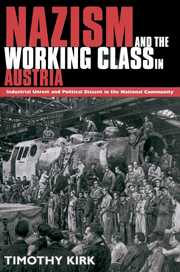 Nazism and the Working Class in Austria
Nazism and the Working Class in Austria Book contents
- Frontmatter
- Contents
- List of tables
- Acknowledgements
- Maps
- Introduction
- 1 Austrian fascisms, ‘Austrofascism’ and the working class
- 2 Economic integration and political opposition between the Anschluss and the war
- 3 The war economy and the changing workforce 1939–1945
- 4 Work discipline in the war economy
- 5 Popular opinion and political protest in working-class communities
- Conclusion
- Notes
- Select bibliography
- Index
3 - The war economy and the changing workforce 1939–1945
Published online by Cambridge University Press: 06 January 2010
- Frontmatter
- Contents
- List of tables
- Acknowledgements
- Maps
- Introduction
- 1 Austrian fascisms, ‘Austrofascism’ and the working class
- 2 Economic integration and political opposition between the Anschluss and the war
- 3 The war economy and the changing workforce 1939–1945
- 4 Work discipline in the war economy
- 5 Popular opinion and political protest in working-class communities
- Conclusion
- Notes
- Select bibliography
- Index
Summary
In terms of its economic objectives the Anschluss was very much a success. For Germany's part, the relief it brought to the depleted labour market in the Reich was a particularly welcome bonus, while Austrians benefited from the rapid fall in unemployment: the number of those out of work in Austria fell by 76 per cent in 1939 to only 3.2 per cent of the workforce. By October of that year there were already fewer than 50,000 out of work in Austria (although there were a further 40,000 on short time). By 1941 there were only 3,000 Austrians still without jobs.
By 1939 then, Austria was sufficiently integrated into the Reich to share all the features of the latter's ‘overheated’ war economy. Very soon there were the same shortages of labour and raw materials in the ‘Alpine and Danubian Gaue’ as in the Altreich, and these were further exacerbated by the introduction of conscription. Between 1939 and 1940 the number of people employed in Austrian industry declined by 10,000 (2.1 per cent). The loss of labour was not even, however, and this small net decline disguised a more significant shift in resources from consumer goods to capital goods. The consumer goods sector, which had already suffered closures and lay-offs, contracted further with the outbreak of war. Its workforce declined by 14.4 per cent, while the numbers employed in the primary sector and in heavy industry rose by 6.8 per cent and 7.1 per cent respectively.
One of the effects of this shift in resources was to create isolated cases of new unemployment, particularly in communities dependent on one industry, such as the hard-hit textiles branch.
- Type
- Chapter
- Information
- Nazism and the Working Class in AustriaIndustrial Unrest and Political Dissent in the 'National Community', pp. 68 - 85Publisher: Cambridge University PressPrint publication year: 1996
